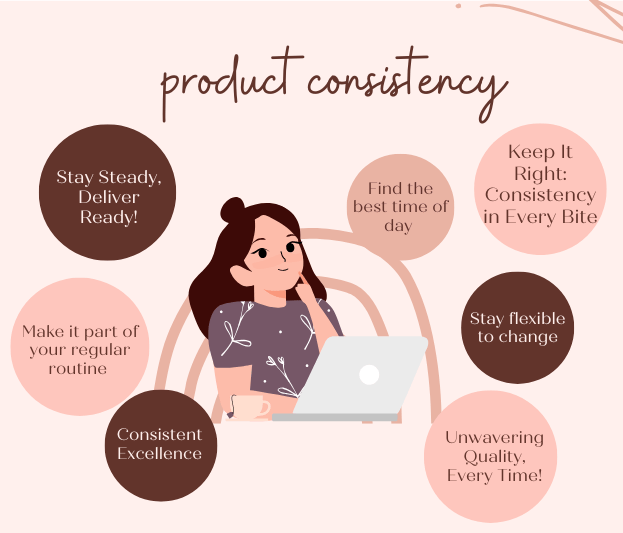In the age of Artificial Intelligence, in a competitive world, businesses must keep updating and maintaining product consistency in line with the world to survive. This is one of the key foundations for the success and benefits of an organization. If products are not regularly introduced to the market, their demand may decrease, and their prices could fall, with the possibility of disappearing from the market. Because product consistency is not just about maintaining quality, it is closely tied to customer trust in the business, the brand’s reputation, and the long-term survival of the company. By producing and supplying consistent products, a company builds reliability in the market and can gain a competitive advantage in the global brand space.
Ensuring product consistency is not just about making identical products; it’s a broad strategy that helps businesses deliver consistent value to customers every day. Customers quickly change brands, so consistent quality is essential. Product characteristics, packaging, delivery, and customer support are all crucial to ensuring consistency. As the business grows, it becomes harder to maintain, like ensuring the same taste across all outlets in a restaurant chain or providing quality service to millions of users in a software company.
This article is important for business owners, quality managers, and operations teams who want top results. It explains how to create effective quality control systems, set up monitoring methods, and establish a culture of consistency. It offers strategies for new business owners or those managing established brands to build trust, which will help bring customers back. The article also highlights the need to create a step-by-step plan to enhance product consistency and improve market positioning.

What is product consistency?
Product consistency refers to a product’s ability to sustain its presence in the market over a long period, maintaining its quality and service standards, and ensuring customer satisfaction while securing a competitive position in the marketplace. To maintain product consistency, special emphasis must be placed on production quality, supply chain management, brand credibility, and customer service. Consistent products generally earn customer trust and contribute to the long-term success of a business.
Why Product Consistency Matters?
Product consistency is one of the key foundations of a company’s success. If a product is not regularly brought to market, its demand may decrease and its value may decline. This is because product consistency is not only about maintaining quality, but also closely related to building customer trust, brand reputation, and the long-term sustainability of the business. Through consistent production and supply of products, a company builds reliability in the market and gains a competitive advantage.
- Builds Customer Trust: Customers expect to receive the same level of quality every time they purchase a product. When a company consistently meets these expectations, it builds trust. Trust, in turn, leads to repeat business, positive reviews, and long-term customer loyalty. A lack of consistency can lead to dissatisfaction, complaints, and negative word-of-mouth, damaging the brand’s reputation; later, these affect the business, which makes you more likely to face losses.
- Strengthens Brand Identity: A consistent product reinforces the brand’s identity. It’s the taste of a popular snack, the design of a tech gadget, or the functionality of a software tool; consistency allows a brand to form a recognizable and dependable image. Customers who identify with the brand’s consistent offerings are more likely to become advocates for the product, spreading positive word-of-mouth and generating organic growth, and the best way to do that is to be quality-conscious about the product.
- Reduces Operational Costs : When products are produced or delivered with consistency, the performance of the process improves. Standardized processes lead to fewer mistakes, less waste, and minimized rework. This can save businesses a lot of money.. Also, consistency helps optimize supply chain operations. It ensures that raw materials and production schedules align with demand.
- Promotes Competitive : Advantage In today’s competitive market, Who must be disclosed separately in business insider reports. One successful way to do so is by offering a consistent product. While competitors may fluctuate in quality or availability, a brand that delivers top-notch products regularly can position itself as a reliable leader in its field. This can provide an edge in most markets where customer preferences are closely tied to quality and reliability.
| Metric | 2022 | 2023 | 2024 |
| Defect Rate | 2.5% | 1.8% | 1.2% |
| Customer Returns | 3.2% | 2.7% | 2.1% |
| Quality Audit Score | 87% | 91% | 94% |
How to Ensure Product Consistency?
Ensuring product consistency primarily works to create a natural and reliable experience for customers. When a company consistently maintains the high quality of its product and service, the customer develops trust as they receive the same level of quality each time. This leads to the customer being eager to regularly purchase that product or brand.
- Install Strict Quality Control: A well-defined quality control (QC) system is imperative to make sure that every product meets the same standard. This involves setting clear guidelines for the materials used, the manufacturing process, and the final inspection of the product before it reaches the consumer. For digital products, this may involve regular testing and updates to ensure that the software remains stable and functional. Companies must also ensure that any defects are addressed and rectified promptly to maintain uniform quality.
- Standardizing processes: the crucial for achieving consistency. You can apply this to both production and service delivery. For manufacturers, this could mean creating a standardized production line to ensure each step is done the same way all the time. For service-oriented businesses, standard operating procedures (SOPs) can help maintain consistency in customer experience. Whether it’s through employee training, customer interaction guidelines, or automated workflows, standardization ensures that the product or service delivered is always the same.
- Monitor and analyze feedback consistently: Collecting feedback from customers helps to identify any inconsistencies in the product. Feedback from online reviews, surveys, and customer service helps companies find flaws in their products or services. Addressing these concerns promptly will help prevent recurring issues and maintain the quality that customers expect.
- Invest in Technology and Automation: Technological advancements have made it easier for companies to maintain product consistency. For example, automated production lines ensure each unit meets the same standards. For digital products, automated test-free tools can check for bugs and performance issues. They ensure that updates or new features do not affect the product’s stability. AI and machine learning can predict problems and improve quality control.
- Conduct regular training for employees: Employees play a significant role in ensuring product consistency. From production workers to customer service representatives, every team member must be well-trained in the company’s standards, procedures, and expectations. Regular training sessions keep everyone aligned with the company’s goals and help them understand the importance of consistency. When employees understand the impact of their role on the product’s quality, they are more likely to adhere to the company’s standards and avoid errors.
- A key aspect of ensuring product consistency is selecting reliable suppliers who can deliver high-quality materials without fail. If a company relies on third-party suppliers for raw materials or components, any fluctuation in quality can affect the final product. Building strong relationships with trusted suppliers ensures that the materials are of the same quality every time, which is imperative for maintaining consistency.

Brand Reputation
A brand builds its reputation over time, and product consistency plays a big role in shaping how consumers perceive the brand. High-quality, reliable products attract more customers. They give companies a competitive edge. On the flip side, inconsistency can tarnish a brand’s image in a short period.
Operational Performance.
Maintaining consistency also helps streamline operations. When products are consistent, processes become more predictable. It makes it easier to manage supply chains, inventory, and quality.
Implementing strict quality control.
Quality control is at the heart of ensuring product consistency. This means setting clear standards for materials, production processes, and final inspections. Automated free tools for testing help reduce human mistakes. They also make sure each product meets the needed specifications. Regular audits and checks are also crucial in catching potential issues early.
Standardizing Processes.
A standardized production process is essential for consistent results. Also, having clear guidelines for every step of manufacturing or service delivery. Consistency in procedures reduces the chances of variability in the end product. Every part of the process, including assembly, packaging, and customer service, requires close monitoring and control.
Challenges in Maintaining Consistency.
- Scaling Operations: As a company grows, maintaining the same level of product consistency can become challenging. Larger production runs, more suppliers, and higher customer demand can lead to fluctuations in product quality. Companies must invest in systems and processes that scale with the business, ensuring that the quality of the product does not suffer as production increases.
- Changing Customer Expectations : Customer expectations may evolve. Companies must adapt to meet new demands. However, we must manage any change in the product with care to avoid inconsistency. For instance, updating a product to include new features should not affect its core functionality or usability, as this could result in a negative customer experience.
- External factors can affect a product’s consistency: These include supply chain disruptions, marketing shifts, and unexpected tech changes. Companies must stay agile and prepare to quickly adapt to these challenges while still maintaining a consistent product experience.

Training Employees.
Employees are vital for maintaining consistency. Regular training helps them understand and meet the company’s standards. The involvement of using proper material handling techniques. Also, customer interactions must align with brand expectations. Skilled, informed employees are key.
Feedback and Continuous Improvement.
To ensure that consistency is maintained over time, it is important to gather feedback from customers and employees. You should address any inconsistencies or potential issues as soon as they arise. A culture of continuous improvement helps find areas to refine. It also keeps the product aligned with customer needs and expectations.
Leveraging Technology.
Technology plays a significant role in maintaining product consistency. Advanced machines, automated tests, and data analytics monitor performance and identify trends in production. Software tools manage inventory and optimize the supply chain. They ensure that every product uses the same materials and that they manufacture it under similar conditions. Keeping your product consistent is vital for trust and loyalty. When customers expect a great experience, they stay loyal to your brand and share it with others. A consistent product boosts your reputation. It makes your brand easier to recognize and more dependable. For your business, it simplifies operations, cuts costs, and aids growth. Plus, when you offer consistent value, you stand out from the competition and can charge more.
| Metric | 2022 | 2023 | 2024 |
| Customer Satisfaction | 4.1/5 | 4.3/5 | 4.6/5 |
| Market Share | 15% | 17% | 19% |
| Revenue Growth | 8% | 12% | 15% |
In a competitive market, consistency is more than a nice thing. It is a key factor in customer satisfaction, brand loyalty, and operational success. By using quality control, standardized processes, employee training, and technology, companies can ensure that their products meet customers’ high expectations every time. Ensuring product consistency is crucial to building a successful and sustainable business. By establishing strict quality control, standardizing processes, and actively listening to customer feedback, businesses can maintain high consistency. This not only increases customer loyalty and trust but also strengthens the company’s brand identity. So, experience has shown that in an ever-competitive market, companies that excel in product consistency will not only thrive but also set the standard for others to follow. An organization that always has to work together to move forward is key to cooperation, which is the key to building a successful and sustainable business.
